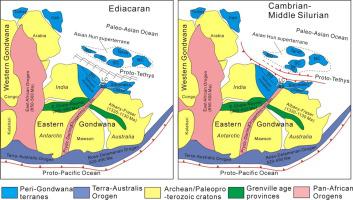Geoscience Frontiers ( IF 8.5 ) Pub Date : 2021-04-06 , DOI: 10.1016/j.gsf.2021.101200 Guichun Liu , Zaibo Sun , Jianwei Zi , M. Santosh , Tianyu Zhao , Qinglai Feng , Guangyan Chen , Xiaomei Nie , Jing Li , Shitao Zhang

|
An early Paleozoic Proto-Tethys ocean in western Yunnan has long been postulated although no robust geological evidence has been identified. Here we investigated the recently-identified Mayidui and Wanhe ophiolitic mélanges in SW Yunnan, which occurs in a N–S trending belt east of the late Paleozoic Changning–Menglian suture zone. The ophiolites consist mainly of meta-basalts (amphibole schists), meta- (cumulate) gabbros and gabbroic diorites, and meta- chert-shale, representing ancient oceanic crust and pelagic and hemipelagic sediments, respectively. Six samples of gabbros and gabbroic diorites from 3 profiles (Mayidui, Kongjiao and Yinchanghe) yielded zircon U-Pb ages between 462 ± 6 Ma and 447 ± 9 Ma, constraining the formation of the Mayidui and Wanhe ophiolites to Middle Ordovician. Gabbros from the Mayidui and Kongjiao profiles share similar geochemical characteristics with affinities to tholeiitic series, and are characterized by depleted to slightly enriched LREEs relative to HREEs with (La/Sm)N = 0.69–1.87, (La/Yb)N = 0.66–4.72). These, along with their predominantly positive whole-rock εNd(t) and zircon εHf(t) values, indicate a MORB-like magma source. By contrast, the meta-mafic rocks from the Yinchanghe profile show significantly enriched LREEs ((La/Sm)N = 0.97–3.33, (La/Yb)N = 1.19–14.93), as well as positive whole-rock εNd(t) and positive to negative zircon εHf(t) values, indicating an E-MORB-type mantle source. These geochemical features are consistent with an intra-oceanic setting for the formation of the Mayidui–Wanhe ophiolites. Our data, integrated with available geological evidence, provide robust constraints on the timing and nature of the Mayidui–Wanhe ophiolitic mélange, and suggest that the ophiolites represent remnants of the Proto-Tethys Ocean, which opened through separation of the Indochina and Simao blocks from the northern margin of Gondwana before the Early Cambrian, and evolved through to the Silurian.
中文翻译:

云南西南部特提斯原生质混杂岩:锆石U-Pb年代学和地球化学的制约
尽管尚未找到可靠的地质证据,但长期以来一直假定在云南西部有一个早古生代特提斯海洋。在这里,我们调查了云南西南部最近发现的马伊多伊和万和的混杂质混杂岩,它们发生在晚古生代长宁-孟连缝合带以南的南北向趋势带中。蛇绿岩主要由偏玄武岩(闪石片岩),偏辉长石(辉长岩)和辉长岩闪长岩组成,以及斜纹硅质页岩,分别代表古代的洋壳和中上层和中上层沉积物。来自三个剖面(马依堆,孔角和银厂河)的辉长岩和辉长岩闪长岩的六个样品产生的锆石U-Pb年龄在462±6 Ma和447±9 Ma之间,这限制了Mayidui和Wanhe蛇绿岩到中奥陶纪的形成。N = 0.69–1.87,(La / Yb)N = 0.66–4.72)。这些,与他们的主要正全岩沿着ε钕(吨)和锆石ε铪(吨)值,指示MORB状岩浆源。与此相反,从Yinchanghe轮廓显示显著富集轻稀土元素的元镁铁质岩石((LA / SM)Ñ = 0.97-3.33,(LA / Yb)的Ñ = 1.19-14.93),以及正全岩ε钕(吨)和正到负的锆石ε的Hf(吨)值,表示E-MORB型地幔源。这些地球化学特征与大洋洲内马德堆—万河蛇绿岩形成的环境是一致的。我们的数据与现有的地质证据相结合,对Mayidui-Wanhe蛇纹混杂岩的时间和性质提供了强有力的约束,并暗示蛇绿岩代表了原始特提斯海洋的残余,该区域是通过将印度支那和思茅地块从中分离出来而形成的。早在寒武纪之前冈瓦纳的北缘,并一直发展到志留纪。











































 京公网安备 11010802027423号
京公网安备 11010802027423号